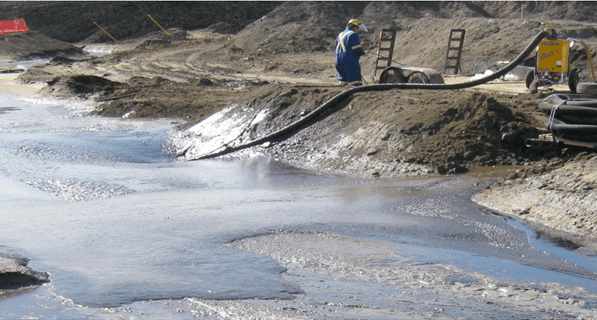SV110-V Pump System – Tar Sands Case Study | SupaVac
Advanced technology SupaVac® solids pump system stands alone – transfers waste sand sludge laden with tar from this extraction plant settling lagoon.
This highly abrasive settling pond waste contains tons of sand and is laden with sticky tar and chunks. Vacuum recovery is accomplished using 25 inches of mercury and discharged with 100 PSI air pressure. No centrifugal or submersible pump or vacuum truck has ever been able to handle this transfer task.
This SupaVac SV110-V pump system was put to the test on a small scale at an extraction plant settling pond. This tar-laden waste sand is abrasive and resistant to flow. These ponds, containing sheets and chunks of hardened tar, have ongoing operational, maintenance and environmental issues.
The current arduous method to remove this sludge and solids from these primary settling ponds is to scoop it up with long reach loaders and transfer it into large trucks for transport. This equipment is requisitioned from a demanding production schedule. As the trucks travel along the roadway to dump the sludge for permanent placement, an environmental trail of sticky sludge marks the journey.
For larger scale operations, based on experience in similar installations, SupaVac envisions injecting air into the lagoon sludge before and during pumping operation to increase the lubricity of the tar components, thereby facilitating a smooth operation. The SupaVac air-assist pickup nozzle, specifically designed to handle this application, when operated with the larger recommended SV250V pump, will enhance the vacuum recovery of this tar-laden sludge. This will maintain maximum flowability characteristics into the pump and for long distance transfer through the pipeline.
The effective discharge capability of the SupaVac SV250-V system in full-scale operations extends to around 1000m+. As just one example of the toughest installations to date, waste drill cuttings are transferred hundreds of feet on and around ocean drill platforms. Other sludge and slurry are being transferred up to a kilometre away.
SupaVac has an impressive international record of accomplishment in pumping the toughest oily sludge, abrasive slurry and bulk solids; tar-sands is a natural challenge in which to improve operational, maintenance and environmental issues.
One of SupaVac’s toughest achievements to date, transferring waste drill cuttings, has become one of the biggest markets for these unique pumps.
Pumping is as much an art as a science. Most solids can be conveyed with a SupaVac pump, with the pump able to transfer solids up to 70% diameter of the inlet hose. Both air and water injection can be utilised to assist in extreme viscous applications and even dry sand has been pumped.
SupaVac air assist pickup nozzle significantly enhances the vacuum recovery. See vortex in photo on left. Sludge discharges back into the settling pond for this evaluation. See horizontal grey trail in middle photo. Waste drill cuttings recovered and transferred on ocean rig and land-based operations. See photo on right.
SupaVac pumps transfer tons of solids with a minimum amount of liquid flow and, for many installations, the addition of makeup water is not required at all. This can significantly reduce storage, handling, trucking and downstream treatment costs and may eliminate the need for dewatering altogether.
These unique pumps can effectively perform many of the same onsite tasks as wet and dry vacuum truck and at a much lower cost, transferring solids up to a kilometre away as the crow flies.
Suction power of up to 25 inches of mercury is generated, effectively drawing sludge and slurry into the pickup nozzle and up through the suction hose into the pump chamber during the load cycle. During the alternate discharge cycle, the entire pump contents are propelled through the discharge hose and pipeline with the force of 100 psi.
Using no electricity, these pneumatic displacement pumps are considered intrinsically safe for use in most plant and x-p locations. SupaVac have invested in global certifications such as CE and ATEX. These pumps operate automatically and require only minimum operator intervention. And with no rotating parts in use and no moving parts in direct contact with the harmful effects of the flow, high reliability has proven to be the experience.
International users include mining giants BHP Billiton, Xstrata and Rio Tinto; petroleum giants Shell, BP and Chevron; service contractor Halliburton, with hundreds of the largest SupaVac pumps worldwide including their North Sea operations.






